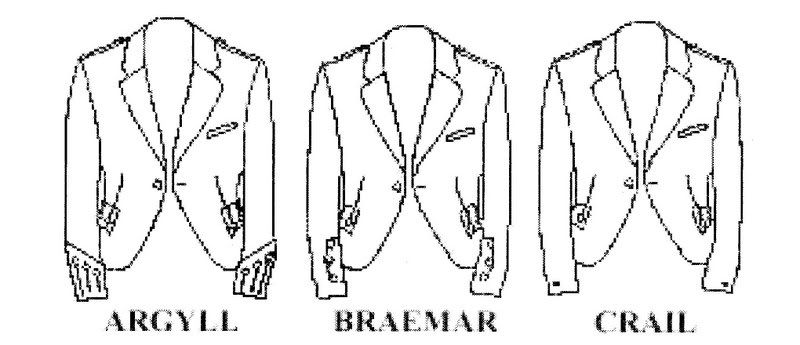Ok first of all you seem to be confusing the fabric that a jacket is made from and the style of jacket.
Tweed is tweed, regardless of who wove the fabric. So any jacket that is listed as made from Tweed will be from similar fabric but may be in different styles.
Please note that I am not going to discuss vest or waistcoats There are just as many different styles of vest/waistcoat as there are jackets and I don't want to confuse the issue.
Let's start the styles with the one that seems to confuse many people. There is a type of jacket that at first glance looks similar to a jacket worn with trousers. It usually has a double vented back that comes down to the crest of the butt.
Depending on what style of cuff it has, and what style of collar it has, some makers will use different names.
Crail/Braemer/Argyle/Killkenny/ are basically the same jacket. Here is a drawing of the first three from the Lochcarron catalog.

You should be able to see that these three are basically the same jacket with the exception of the cuff treatment. All three are single button front jackets with scalloped and buttoned pocket flaps and epaulettes.
A Crail has a single button on a closed cuff. This means that there is no small flap where the button is.
A Braemer has a placket cuff with three buttons. This is the same cuff style found on a Prince Charlie which you will learn about later.
An Argyle has a gauntlet cuff also with three buttons.
Either of these jackets may be made from Tweed for day wear or some other fabric. The most common fabric for more formal wear is called Barathea. It is usually black.
There are a very similar jackets which is called Killkenny. This is supposed to be an Irish jackets and will have a shawl collar instead of the notched collars of the first three.
To sum up so far if these four are made from any Tweed fabric they are considered day wear. If they are made from Black Barathea weave wool they are considered more formal, - Business suit to black tie equivalent depending on the other accessories.
There is one further style of jacket but it is not seen too often. I carry one style of these but they are exclusive to me. These styles are called Wallace style by one maker.
They usually have a straighter, 2, 3 or 4 button front. They usually have a normal suit jacket type of cuff with 2, 3, or 4 buttons. They usually do not have the scalloping to the pocket flaps and do not have epaulettes. These are usually sold as the equivalent to a regular suit suitable for day or business wear depending on the fabric they are made from.
One level up in formality are the two jackets called the Prince Charlie (note that it is not 'Bonnie Prince Charlie') and its Irish equivalent the Brian Baru. These are short like military mess dress and have tails, (we call them tashes) in the back.
Again the PC has a notched collar and the Brian Baru has a shawl collar. There may or may not be other differences depending on the maker.
The standard fabric for the PC and BB are, like the Argyle, Black Barathea Wool. Other fabrics may be used such as velvet or other colors.
The Prince Charlie and Brian Baru will almost always have satin lapels so that moves these into the Tuxedo range of formality.
I tell my customers that these two should only be worn when a tuxedo would be appropriate.
I'm not going to go into the 'Doublet' range of jackets other than to describe their features. There are others here far more versed in those styles. I don't own one and probably never will.
The Regulation Doublet is basically a Prince Charlie with two, or double, the number, of tashes.
The Montrose is double breasted and the Sheriffmuir looks single breasted but has buttons on both sides and is worn open.
Doublets are often worn with lace jabot and lace cuffs. Some think that Doublets are the kilt equivalent to White Tie and Tails but I disagree.
Last edited by Steve Ashton; 8th October 14 at 02:29 AM.
Steve Ashton
www.freedomkilts.com
Skype (webcam enabled) thewizardofbc
I wear the kilt because: Swish + Swagger = Swoon.















Bookmarks